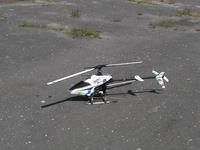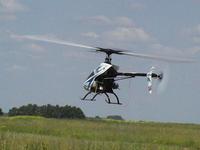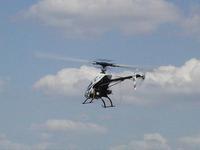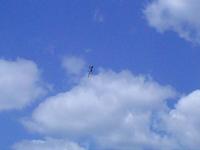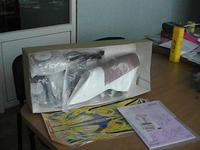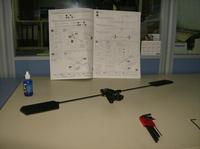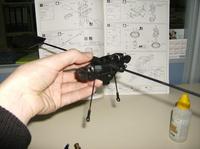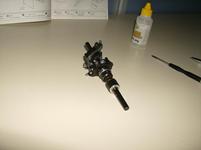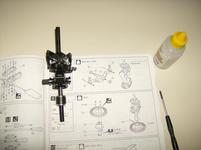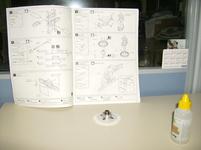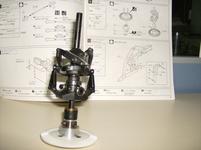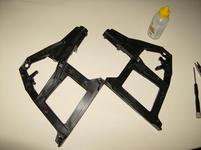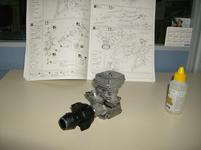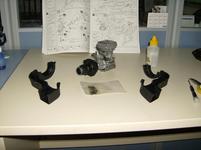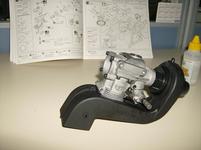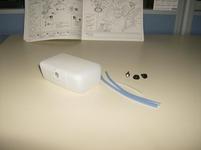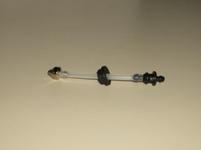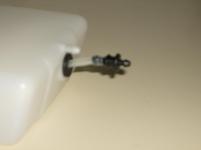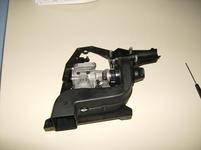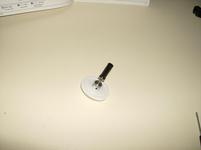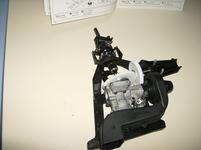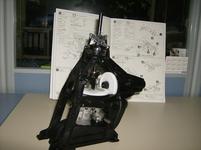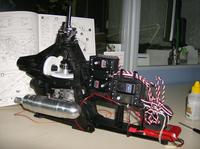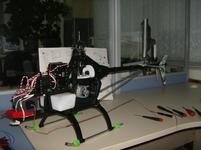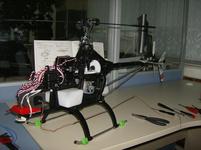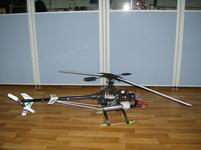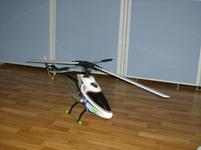
Kyosho Concept 46VR
- Preamble
- Technical datas
- As it flies
- Construction
- That in a composition
- That is necessary for assembly
- Assembly
- About helicopter engines
- That is broken
- Summaries
Preamble
Perhaps, to begin follows that the first version of the review of helicopter Kyosho CONCEPT 46VR differed nothing from the majority of reviews of models which one I could read. But, thanks to annoying contingency, it has completely disappeared. It was necessary to begin all at first. And I have decided not to recurring. Really, CONCEPT 46VR it is effected from time immemorial, and to write about him as about a revolutionary novelty it would be aberrant. Though, CONCEPT 46VR it is not similar to one of helicopters known for me, except for more "ancient" colleague – Nexus Legato. The main difference consists in, so-called, freely hanging arms. But about it later.
Technical datas
- Length – 1080 mm.
- Breadth – 140 mm.
- Altitude – 420 mm.
- Weight – 3100 g.
- Diameter of the chief curl – 1245 mm.
- Diameter of a caudal curl – 230 mm.
- The drive – 7,5–8 cubic see
From the reference specifications it is visible, that the helicopter on the sizes corresponds to 30 cl, if not the drive. The generator recommends drive O.S. MAX-46FX-H RING, that gives the helicopter power to weight ratio 50 cls. Running forward, I will tell, that the indicated drive to gain it is inexpedient – a piston pair now not to buy. In my case has ideally approached Thunder Tiger Pro 50H-R. Though MAX 46th I too put. But, before to be sunk in design features, I wish to be divided by the judgement on flight properties CONCEPT 46VR and to feature feels from control of model.
As it flies
How much overhung arms influence handling qualities – to judge I not undertake. Having experience of control by helicopter 30 cls Kyosho Caliber 30, I expected similar behaviour and from Concept’а. But my expectations were not justified, and in good sense, from the very first take-off.
The lift-off has happened easily and I practically did not feel «effect of land». At execution of horizontal figures it is easy enough to retain a given longitude. Generally, agility CONCEPT 46VR can be compared to a motorcycle in urban plugs. The helicopter precisely completes control. Thanks to very powerful drive (for this helicopter), in vertical plane Concept also precisely reacts to control of collective step of arms of the chief curl. It allows to retain a flying height easily.
Contrary to ordinary judgement, that helicopters with smaller diameter of a curl are less stable, Concept demonstrates excellent stability, both in a statics, and in dynamics. Such figures as "barrel", "buttonhole", "tumbling" are executed generally with a minimum of "taxiings". The wind to 5 km/s on turns practically is not felt. But the wind with heavy gusts swings hanging model as a bell.
In the general summary helicopter CONCEPT 46VR is good for optimisation of skills of piloting. And I tend to thought, that Kyosho, having coagulated production Concept’ов in favour of serial Caliber, have acted not absolutely reasonably. Caliber 30 has much smaller flight potential, and green enough Caliber 5 - very wanton for the "not strong" pilot.
Construction
Structurally CONCEPT 46VR is helicopter of the classic scheme with one bearing curl. The torque transfer on the chief and caudal curls is effected by means of a gearing. Linking of the reduction gearbox to an axis of the chief curl is effected through a free wheel representing the bearing of single-sided gyration. The reduction gearbox is settled in such a manner that gyration of the shaft of the drive is transmitted directly to a drive axis of the caudal reduction gearbox, and from it on the chief curl. Such scheme has one virtue – in default a free wheel and, as consequence, transferring of the chief curl in a windmilling to be stored the control capability by a caudal curl. But the deficiency overbalances - at such scheme the stimulated autorotation because of subitaneous switching-off of the drive is practically impracticable. With stopped caudal curl the helicopter is not operated on a direction. Moreover, in the given condition the tail boom rule depends on pulp of factors, such as a roll, tangage, a wind direction, etc.
The helicopter drive places under the shaft of the chief curl and is fixed by a trier head downwards. The Fuel tank is leached in a nose of the helicopter and all is sheltered by a fuselage. Therefore to watch of a propellant consumption in air it is practically impossible. Output the fuel tank union is disposed above the drive carburettor. Therefore it is necessary to charge very snug combustible in a filling chest. Charging «under a knot» result ins to a drive bay, and combustible pours out from the carburettor air intake endways on land.
Helicopter frame plastic with multiple stiffening fins, and very compact. Generally, engineers Kyosho have tried to concentrate peakly weight of model at an axis of the chief curl. As consequence – tall agility.
The bearing curl is resulted by a plastic bevel gear. Steel (8 mm) the shaft of the chief curl leans against two ball-bearings. A swashplate spacer metal-plastic, as well as pitch-compensator levers. System of dubbing of a swashplate the tillage. The head of a bearing curl has an original construction. In it trunnions of arms fasten to a rotor head not rigidly through interbladed the shaft, and to axels which one have a capability loosely to be wedged on some corner in a vertical plane. Besides, the head construction envisions a servo-axis disposition in a plain of gyration of the chief curl. I can not tell, what flight advantages are conditioned by the given construction, but at making of duplicator model all these habits will appear very opportunely.
The caudal curl is resulted by the shaft in which one role the customary steel rod having the O-shaped rounding in forefront appears. The shaft is freely interposed by this end into a limit switch of a shaft gear of a driving of a caudal curl. Perhaps, the construction of a mechanics of a caudal curl is thought least over, includes pulp of devices, is inclined to chatterings and is fraught with complete damage in an emergency.
Control of helicopter is effected by means of five servos standard sized. For their accommodation to frame forefront the additional frame of servoassemblies fastens. The deflexion of steering levers of machines of bank control, is transmitted by a pitch and step by a principle "pull-push". It allows to eliminate effect of buckling of traction bar at thrusting driving. Strangely enough, the machine of pitch control of a caudal curl is leached in the bow of the helicopter, on a level with the gas machine. If the machine of gas does not test any counteraction from a shutter of the carburettor and presence of the long traction bar at all does not aggravate quality of engine control, in a case with a caudal servo a situation opposite. The traction bar consisting of two halves in total length more of metre, despite four point of suspensions catches tightly and is subject to chatterings. To solve a problem it is possible at the expense of accommodation on a tail boom of a bracket for a servo but then it is necessary to update the launching assembly for utilisation of a starter with the hexahedral launching shaft.
The engine start-up is effected as in models of airplanes – it is necessary to press the starter adapter to the conical adapter of the shaft of the drive. As this tumulus is under a helicopter beam, to crank an engine inconveniently. Noting that at least time in life the modeller tries to acquire the drive with the declutched sender or not cleaned gas such way of an engine firing is represented also dangerous.
The exhaust system, it a deafener, is disposed so, that overlaps access to an idle needle. But the deafener going complete with helicopter can be twirled round a discharge pipe. A trouble that this regular deafener, judging by the sizes, for the drive 30 cls. And if to put on the helicopter the drive 50 cls the deafener needs to be changed uniquely, differently the drive long will not bunk. But a deafener with gyrated discharge pipe – a piece not especially propagated, therefore it is necessary to be oriented on flow bundle a deafener-exhaust a tube. Then and to twirl it is necessary nothing – the main thing, a tube of the appropriate flexure to select.
That in a composition
The helicopter in completely taken apart kind delivers. The drive and control electronic parts are gained separately. The box with a composition possesses retiring overall dimensions. When it has opened, the first thought was: «… also what, the helicopter which one I saw on a bench from this should be received?». All configuration items are spread out in plastic bags. Each package has marking on which one links in main plans are done. The order bookings to the helicopter, is the booklet containing the detailed, well illustrated operating instruction on assembly, disassembly and changeover of some hitches and elementary tuning. The operating instruction bilingual - English-Japanese. The text a minimum, all is clear under draughts.
That is necessary for assembly
For helicopter assembly hexahedral clues which one enter in a composition complete set were required. Two cross screwdrivers are still necessary, at least. One - for a twisting of propellers and self-machine cuts, and second for a twisting of propellers of fixing of ball-and-socket emphases. These propellers have very thin slit, therefore I accepted a screwdriver from a repair kit of mobile phones. I have successfully exchanged indispensable spanner wrenchs a rib joint pliers. Besides, carving clampers dark blue both red, and epoxy resin were required. Last it is necessary for fixing of plates on komli arms of the chief curl. I have applied a resin with 30 minute consolidation.
Assembly
Recently in our forums to occur there were often enough problems of newly-baked holders of helicopters of serial Concept which one have gained them in a pre-assembled kind. For these our colleagues I have decided to assembly process in the review to pay the special attention.
I effected assembly in that order which one is set up in the operating instruction. The first assembly which one should be collected, was the servo-axis assembly. Was very relevant at once to centre an axis. If it not to make, axis shoulders will be received miscellaneous length, and it in turn, will lead to chatterings of the chief curl. Servo-blades at the helicopter all-cast and on an axis are simply wound. If the blade new and in them still is not present a carving to wind them it is necessary simultaneously with the uniform effort and is unceasing. Kyosho recommends to twist an axis in a blade on depth of ~30 mm. It is quite good, if on this spacing interval from axis edge to deliver marks. Then it is possible to check uniformity of a wire-wrap of both blades visually. I resemble, it is a question of new blades.
The assembled assembly simply enough is poised. For this purpose it needs to be placed in bottom of the enclosure of a head. And the enclosure on the surface levelled off on level. Last requirement is binding.
The following step, assembly of trunnions of the chief curl. Here there is one habit: it is not necessary to append the special efforts, winding a screw nut on an axel – it is possible to break.
At assembly of a head I have established at once bent for to a cradle gyrating a servo-axis. Kyosho recommends it to do after a head final assembly. I tried – better in the course of assembly.
The main shaft delivers with the pitch-jack established on him, a skew spacer, stop rudder blade, the bearing and a pitch control slider. A stopper, this ring on the shaft, a vertical displacement preventing it. It is necessary to cushion all four screws on stop rudder blade and to pull the shaft a little hill up. Further it will simplify process of adjustment of the shaft in a frame.
At assembly of the chief pinion was very relevant to fit on it uniformly, without skews, that on it there would be no "figure of eight".
Preparation for engine mounting very responsible stage. The bucket clamper is indispensable. Bearings, an adhering bell, the clutch plate and a blower impeller are fitted on the drive shaft. All this facilities is fixed by one screw nut with which one it is NECESSARY to lubricate with the red clamper of a carving.
With the special attention it is necessary to treat to adjustment of the jacket of chilling on the drive. It consists of two parts subtended by five propellers. It is necessary that the claw of ridge of one half on all length has entered in a notch of ridge of other half. The jacket form complicated, therefore it is easy to overlook.
Union adjustment in a fuel tank too, strangely enough, demands accuracy. The matter is that the union, besides the main role plays still a role of the clamper of the elastomeric sealing ring and is established in this ring by simple indentation. If to be overzealous, both the union and an elastomeric ring will appear in a filling chest. I for the present have not guessed, as them therefrom to get.
Further all pre-integrated hitches are established on a frame. Simple accuracy and attention here is required, specially at engine mounting. The engine mount is established without problems, but the chilling jacket on the drive is not snapped, therefore it is necessary to track that all claws of the jacket would rise in the appropriate notches on a frame. After engine mounting it is necessary to twist the shaft – the impeller should not scrape on an interior surface of a cooling-water jacket.
Establishing hitches on a frame, I have collided with a surprise. According to the operating instruction, the drive axis of the caudal reduction gearbox should deliver as an assembly with fixed pinions, bearings, the adapter of adhering with the caudal shaft. Anything look-alike. All above-named components existed in a composition separately from each other, but, in one bag. To collect this assembly not complicatedly. Only without a hammer not to be bypassed. By means of it the plastic pinion of a power take-off of the drive is mounted on a metallic pinion of a driving of a pinion of the chief curl. Both pinions are fixed on the shaft by means of four screws. After a final assembly of halves of frame it is necessary to check up, whether the plastic pinion of a lobby or a trailing edge about a frame rubs. If the given fact occurs to be, it is necessary to cushion screws and to bias a pinion. For provision of access to these screws in a frame there is a pinhole.
It is necessary to mark, that that with drift of a plastic pinion also the metallic back will be mixed. As a result between cogs of a metallic pinion and a plastic pinion of the chief curl there is a backlash. To eliminate it it is possible, having uplifted a pinion of the chief curl. For this purpose it will be necessary to cushion stopper the shaft of the chief curl, to turn off the propeller fixativing a pinion on the shaft, to pull the shaft hill up to its yield from the lower bearing and to enclose between the bearing and a pinion a screw nut of indispensable depth with an inner diameter of 8 mm. To return the shaft in an at-rest position, to snap a pinion, to snap the stop lane
It is necessary to fasten a silencer and a frame of servoassemblies. Here any habits. The fuel tank is established in a servo-frame and tubes from it transit in immediate proximity from the drive. It is necessary them so to dispose that they did not touch it.
The following stage of "a large path» - tailing assembly. The tail boom in a composition delivers in a pre-assembled kind. Here the explanation is necessary: all presobrannost consists in the bushes established in a beam and the steel tube threaded through them – guide for the caudal shaft. In the form of renewals the tail boom delivers without bushes and guide, therefore these accessories will be necessary for establishing independently. The tube or a rod in diameter of 13-15 mm with which one help of the bush are driven in a tail boom Is required. It is necessary to allocate only three bushes on strictly certain spacing interval from the end as it is featured in the operating instruction.
Adjustment on a beam of guides of a pushrod a caudal curl from me has demanded fair efforts. This guides one-piece also enters on a tail boom tube very reluctantly.
Assembly of the caudal reduction gearbox and curl very explicitly is featured in the operating instruction so to retell it there is no sense. Easly, as well as an undercarriage, and fixing of a head of a bearing curl on a main shaft.
Closing phase of assembly – adjustment of servos, tuning of control rods. I will begin that servos it is necessary to pick up of 3-5 kg with an effort., disk-shaped cradles having in the complete set. For control of gas especially strong machine is not necessary, and here on a tailing numeral Futaba S9254 and gyro GY-401 – optimum version.
With selection of machines for control of a skew and step of a bearing curl I did not suffer, in a reserve were Hitec HS-925MG. On gas I have delivered Futaba S3001.
Before beginning regulation of lengths of thrusts, it is necessary to establish all servos in a neutral position. All case histories in the operating instruction are applicable only in this case.
It is necessary to mark, that thrusts from servos have the Z-shaped ends. The parent of a select of such solution designers Kyosho to me is not clear. It is desirable to exchange thrusts others, with a wound ball-and-socket arrowhead as Z-shaped thrusts brad a pinhole in a servo cradle. Control accuracy suffers from it.
It is necessary to give the special attention to a pushrod a caudal curl. It should advance freely without seizing. If it not so it is necessary to check up all guides on a tail boom. As I spoke already, guides put on with a large effort, therefore precisely to orient them is problematic.
Here that in Concept’е very much it was pleasant to me, so it is a quick-detachable fuselage. Only three clamping points. To carve in him a window under "windscreen" I did not become. Practice displays, that a fuselage it not for appearance, and a protective equipment first of all electronic devices of the helicopter from "strokes of bad luck". I have screwed on an appended transparent plate, perhaps, only for affirmed centering. And under it on a white plastic material of a fuselage has pasted a black film. Without it the helicopter was badly visible. In a top of a fuselage I had to excise a deltoid pinhole since electronic parts very strongly heated up.
Last accent – preparation of arms for adjustment, and them, naturally, adjustment. CONCEPT 46VR delivers with wood arms in length of 530 mm. Arms are fitted by a white film, but with not pasted plates. To paste plastic plates, it is necessary to cut off snug a film under an installation site. Was relevant that the boundary of a shear did not fall outside the limits a plate. A free blade face from a film and a plate inside are lubricated with epoxy adhesive. Then fixed plates are subtended by a propeller, and the arm butt for days is cliped in vice.
After the termination of polymerisation of adhesive of the arm are established in trunnions and the helicopter it is off-the shelf to space flight training. Close inspection of all gears, a vehicle-borne battery charge, tuning of flight conditions and the gyro. Exit road afield and the first engine firing.
About helicopter engines
I have already featured flyings in the beginning the review, and about drives I wish to tell separately. The first drive of mine Concept’а O.S. MAX-46FX-H RING has lived not long. Roofing felts any mud has got in the carburettor, roofing felts I it has superheated, but as a result a thumbpiece has wedged aloft. At dismantling teases on the bucket and the cylinder have been found. A stock pair on this drive to me to discover it was not possible, and to buy the drive which is not ensured with renewals, I have considered inexpedient. Has decided to try our domestic МДС-48КУ. Has tried. … I do not present, as this drive generally can be set up. It was superheated even on a rich mixture.
In general, my friend, looking at my tortures, has tendered to try, liing at it in reserve Thunder Tiger Pro-50H (R). However, to me under it other deafener to buy it was necessary. As I wrote above, the deafener delivered in a composition, for drives 50 cls does not approach. With drive TT I flew away to a fallow of gal.s of combustible already. Between 46th and 50th drive I practically have not experienced an odds. Though TT Pro-50H (R) in tuning it is more complicated, than drive O.S., but renewals are.
That is broken
As is known, any modeller occasionally drops model. Not minula this bowl and me. In this connection I will feature effects of "crash-test".
- At rough landing with a null angle of bank and tangage concerning horizon there is a high probability of breaking of landing gears and a tail boom recurvature.
- If touch with land happens under some angle arms are broken, the servo-axis is bent, axels of trunnions, a main shaft are bent.
- At shock by arms about land on drive high speed wrests cogs at a pinion of the chief curl.
- Even small strain of a tail boom demands changeover of a beam and the shaft of the caudal reduction gearbox.
- Strangely enough, a plastic head to me to break it was not possible. A frame, as a whole, too. But at breaking of landing gears on a frame eyes of attachment of the chassis are broken off. As a result the frame becomes unfit for use.
- The engine positioning downwards is fraught with a head, at chassis breaking, breaking of cooling fins of a trier head.
- At shock by a tailing, the alive helicopter in this part remains nothing.
Summaries
Finishing the review, I wish to summarise experience of "dialogue" with CONCEPT 46VR. To place estimates.
Pluses:
- The deliverable composition of censures to quality does not call. Completeness complete,
- The appended operating instruction peakly illustrates process of assembly,
- High-quality plastic material,
- Friend disposition of electronics,
- There are control linkage backlashes,
- Short thrusts in a combination to system "pull-push" ensure very much fine control,
- The original construction of a bearing curl ensures tall agility,
- The powerful drive allows to execute a serial of figures without the considerable power dissipation.
Minuses:
- It is impossible to trace a propellant consumption aloft,
- Access to a needle of an idle is impeded,
- Unsafe start-up system of the drive,
- The tailing construction is that, that at emergency is wrecked considerably,
- At an autorotation the tailing is uncontrolled.
Grand total such: CONCEPT 46VR the good helicopter, in the presence of a radiant of renewals. Possesses a tall flight potential for pilots of incipient and mean proficiency.
The helicopter for the review has given store of Hobby a Center.
Similar pages:
